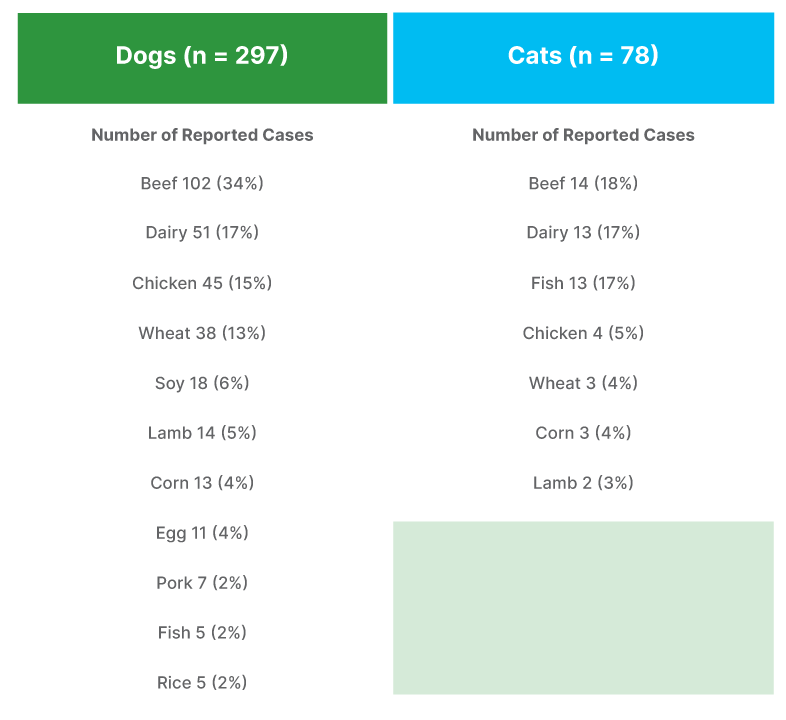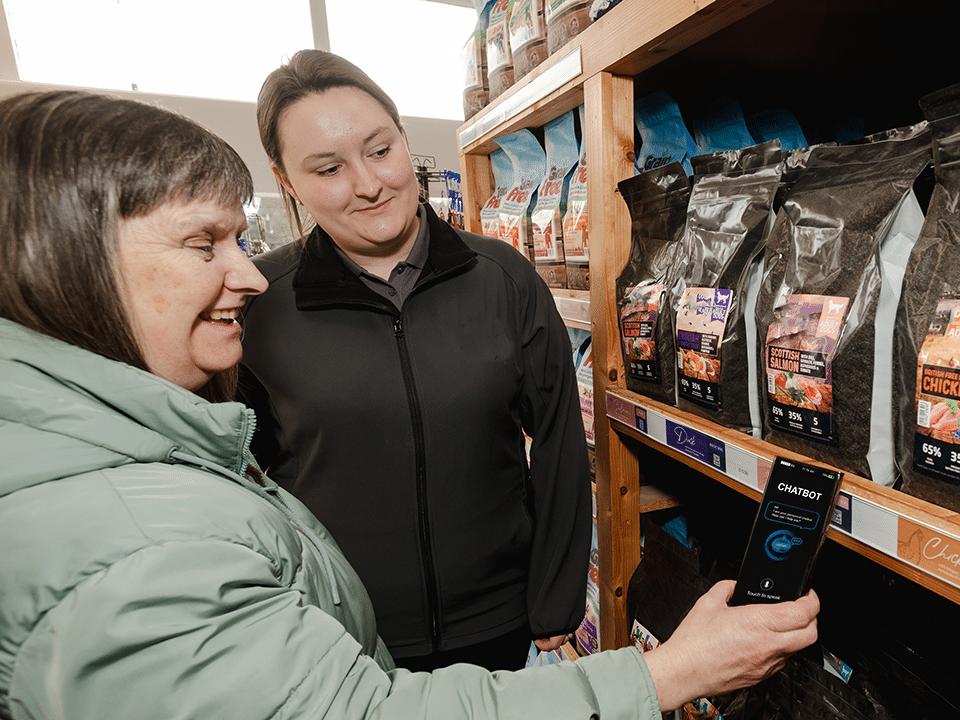
What is a food allergy in dogs and cats?
Dogs and cats may display adverse reactions to food that can be broadly divided into two groups – immunological (food allergy) and non-immunological. A food allergy is an inappropriate immune reaction to a normal food or ingredient (e.g. a protein in the food) which can result in dermatological (e.g. red, itchy skin) and/or gastrointestinal (e.g. diarrhoea, vomiting) signs in dogs and cats (Verlinden et al., 2006). While ingredients such as chicken, beef and soya are readily recognisable as protein sources, it is also important to consider ingredients that are primarily providing carbohydrates to the recipe such as rice, wheat, potato, and corn as these also contain a small amount of protein. Non-immunological adverse food reactions can result from a number of causes such as food intolerance, food poisoning, food toxicity and dietary indiscretion (Verlinden et al., 2006).
Clinical signs of food allergy, food intolerance, food poisoning and dietary indiscretion can overlap, making it difficult to determine the cause and may lead to an adverse food reaction to being indiscriminately labelled by an owner as a ‘food allergy’. In some respects, it is not necessarily important to an owner whether their pet has, for example, an allergy or an intolerance to wheat gluten since the symptoms in both cases can be resolved in the same way – by removing the ‘offending’ ingredient from the diet of the pet.
Common food allergens
Food allergies can develop in response to any dietary protein and those most frequently associated with food allergies are shown in the table below. It is not that these protein sources are intrinsically more ‘allergenic’ than other proteins but probably reflect the widespread use of these ingredients in pet food.
Table 1: Most frequently reported food allergens involved in cutaneous adverse food reactions in dogs and cats (Mueller, et al., 2016).

Identifying the cause of food allergy
If a food allergy is suspected, the gold standard approach to determine the cause is by exclusion diets and re-challenge trials, although this would not discriminate between a food allergy and a non-immune mediated food reaction.
The key to exclusion diet trials is to exclude the possible ingredients the pet is allergic to by selecting a novel protein (and carbohydrate) source to which the dog or cat has not previously been exposed. The diet chosen must be fed exclusively (meaning no other food or treats should be fed alongside) for the trial period. The duration the diet is fed for will depend on the initial severity of the symptoms and on how quickly the clinical signs recede, for example, 2-4 weeks for gastrointestinal symptoms and 4-8 weeks or potentially longer for dermatological symptoms (Verlinden et al., 2006).
Once symptoms have improved sufficiently, re-occurrence of symptoms when re-challenged with the original food or individual ingredient supports the diagnosis of food allergy and identification of the specific protein to which the pet is sensitive.
Although elimination diets help owners to single out particular food types, it can be quite daunting for the owner. The process can be slow and time-consuming, to be effective it takes dedication and owners may not see immediate results.
The Basis of Hypoallergenic Pet Food Diets
Historically, hypoallergenic pet food diets avoided the use of common food allergens (e.g. beef, dairy, wheat, soy) and instead were based on novel proteins (e.g. lamb or salmon), which were not typically used to formulate pet foods, on the basis of a reduced likelihood of being allergic to a protein to which a pet had not previously been exposed. This approach can be very effective for many dogs and cats (Jeffers et al., 1991; Leistra & Willemse, 2002) although it may be necessary to try more than one novel protein diet until a suitable diet is found. It is also possible that the pet may eventually develop an allergy to the novel protein.
A number of pet food companies have marketed their products as good or suitable for pets with allergies or intolerances, due to being a ‘Limited Ingredient Diet’. The recipes usually use only one source of animal protein and one carbohydrate source. The ‘Limited Ingredient Diet’ trend seemingly links back to the idea of an elimination diet, as previously mentioned, excluding certain ingredients to try and limit the risk of an adverse food reaction.
More recently, hypoallergenic pet food diets have been introduced to the market that contains hydrolysed proteins. By using controlled enzymatic hydrolysis, proteins can be partially or extensively broken down into smaller peptides that can be too small to be detected by the immune system, making them hypoallergenic. One advantage of this approach is that they can be effective even in pets allergic to intact protein. For example, dogs that showed adverse gastrointestinal and/or dermatological signs following ingestion of soy protein did not show any clinical signs in response to ingestion of hydrolysed soy protein (Puigdemont et al., 2006). Similarly, in a study of 12 dogs with cutaneous manifestations after exposure to chicken meat, all but one showed a reduction in clinical scores when fed hydrolysed chicken (Ricci et al., 2010).
Trends & Consumer Perceptions
In 2018, an analysis of a unique database of 350,000 UK dogs showed a 75% increase in requests for hypoallergenic dog food blends from owners over the past two years (Woodmansey, 2018). Humanisation is an ever-growing trend in the pet food industry, where many pets are considered ‘children’ or ‘fur babies’ and therefore an additional members of the family. This has been reflected when it comes to hypoallergenic pet food. As many owners have become concerned about whether their diet is free from gluten to suit an intolerance they have or feel they may have, the same concerns have been applied to their pet’s diet.

Summary
As outlined above, there are a number of solutions which may prove effective for providing a diet suitable for a pet suffering from a food allergy or intolerance. When used in the correct way with clear and detailed substantiation, hypoallergenic pet food claims can aid consumers to make an informed choice for their pet to support their nutritional needs.
References
Jeffers, J.G., Shanley, K.J., Meyer, E.K., (1991) Diagnostic testing of dogs for food hypersensitivity. Journal of the American Veterinary Medical Association, 198(2), 245-250
Leistra, M., Willemse, T., (2002) Double-blind evaluation of two commercial hypoallergenic diets in cats with adverse food reactions. Journal of Feline Medicine and Surgery 4, 185–188.
Mueller, R.S., Olivry, T., Prélaud, P., (2016) Critically appraised topic on adverse food reactions of companion animals (2): common food allergen sources in dogs and cats. BMC Veterinary Research. 12:9. DOI 10.1186/s12917-016-0633-8.
Puigdemont, A., Brazís, P., Serra, M., Fondati, A., (2006) Immunologic responses against hydrolyzed soy protein in dogs with experimentally induced soy hypersensitivity. American Journal of Veterinary Research, 67(3), 484-488.
Ricci, R., Hammerberg, B., Paps, J., Contiero, B., Jackson, H., (2010) A comparison of the clinical manifestations of feeding whole and hydrolysed chicken to dogs with hypersensitivity to the native protein. Veterinary Dermatology, 21, 358–366.
Verlinden, A., Hesta, M., Millet, S., Janssens, G.P.J., (2006) Food Allergy in Dogs and Cats: A Review. Critical Reviews in Food Science and Nutrition, 46(3), 259-273.
Woodmansey, D., (2018) Database shows 75% rise in hypoallergenic food demand. Veterinary Times. https://www.vettimes.co.uk/news/database-shows-75-rise-in-hypoallergenic-food-demand/

Sophia Parkinson
GA Pet Food Partners Pet Food Claims Expert
Sophia is GA Pet Food Partners Pet Food Claims Expert and is involved in checking partner claims, ensuring their labels and marketing materials meet regulations, and researching new and exciting raw materials. Sophia has an undergraduate degree in Nutritional Sciences, where she developed a strong interest in claims and labelling regulation. Briefly working in the Human Food industry before joining GA in 2020. She enjoys cooking and going for long walks with her miniature schnauzer, Dexter, in her spare time.

Dr Adrian Hewson-Hughes
Nutrition, Food Safety and Innovation Advisor
Adrian graduated from the University of Sunderland with a BSc (Hons) in pharmacology and went on to work in a Multiple Sclerosis laboratory at the Institute of Neurology, University College London where he obtained a PhD. After several more years as a ‘postdoc’ in academia at the Universities of Cambridge and Nottingham, he joined Mars Petcare and spent 14 years working in R&D at the Waltham Centre for Pet Nutrition. Adrian led various research projects on palatability, feeding behaviour, nutrition and metabolism in both cats and dogs resulting in scientific publications, presentations and product innovations. In October 2018, Adrian joined GA, excited by the opportunity to support the continued innovation and investment that GA commits to, bringing the highest quality products to our Partners and our pets.
You may also like...
Article written by Sophia Parkinson and Dr. Adrian Hewson-Hughes
The Pros and Cons of AI in Pet Retail
You may have frequently encountered the term “AI” or “AI technology” in the media. From unlocking your phone using Face ID, asking for directions on your [...]




